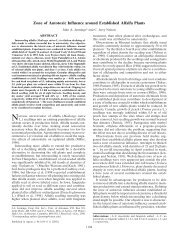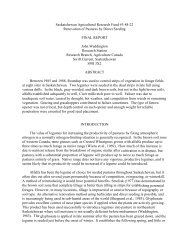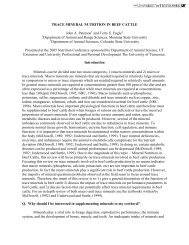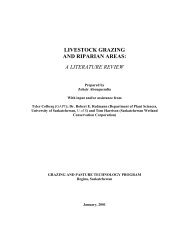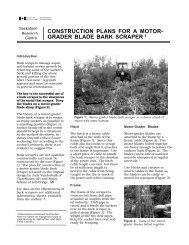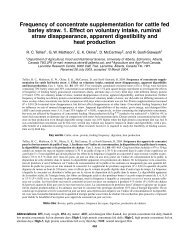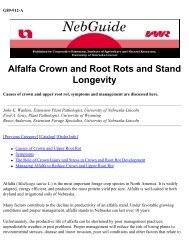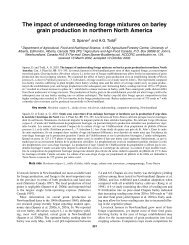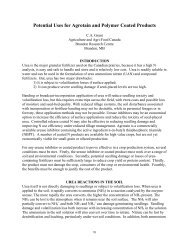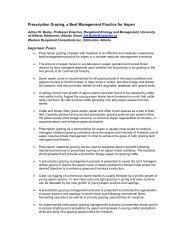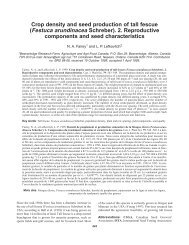Antioxidant and antileukemic properties of selected fenugreek ...
Antioxidant and antileukemic properties of selected fenugreek ...
Antioxidant and antileukemic properties of selected fenugreek ...
You also want an ePaper? Increase the reach of your titles
YUMPU automatically turns print PDFs into web optimized ePapers that Google loves.
Can. J. Plant Sci. Downloaded from pubs.aic.ca by Alberta Gov't Library on 05/12/11<br />
For personal use only.<br />
<strong>Antioxidant</strong> <strong>and</strong> <strong>antileukemic</strong> <strong>properties</strong> <strong>of</strong> <strong>selected</strong><br />
<strong>fenugreek</strong> (Trigonella foenum-graecum L.) genotypes<br />
grown in western Canada<br />
S. N. Acharya 1 , K. Acharya 2 , S. Paul 3 , <strong>and</strong> S. K. Basu 4<br />
1 Agriculture <strong>and</strong> Agri-Food Canada Research Centre, Lethbridge, Alberta, Canada T1J 4B1<br />
(e-mail: suria.acharya@agr.gc.ca); 2 Department <strong>of</strong> Botany, University <strong>of</strong> Calcutta, Kolkata, WB India 700018;<br />
3 Laboratory <strong>of</strong> Experimental Immunology, Department <strong>of</strong> Botany, Gurudas College, Kolkata, WB India 700054; <strong>and</strong><br />
4 Department <strong>of</strong> Biological Sciences, University <strong>of</strong> Lethbridge, Lethbridge, Alberta, Canada T1K 3M4.<br />
Received 5 February 2010, accepted 20 September 2010.<br />
Acharya, S. N., Acharya, K., Paul, S. <strong>and</strong> Basu S. K. 2011. <strong>Antioxidant</strong> <strong>and</strong> <strong>antileukemic</strong> <strong>properties</strong> <strong>of</strong> <strong>selected</strong> <strong>fenugreek</strong><br />
(Trigonella foenum-graecum L.) genotypes grown in western Canada. Can. J. Plant Sci. 91: 99 105. Fenugreek(Trigonella<br />
foenum-graecum L.) is an annual forage legume known to have a number <strong>of</strong> important medicinal <strong>properties</strong> such as being<br />
anti-diabetic <strong>and</strong> hyperchloesterolaemic among others. In this study we have investigated the anti-oxidant <strong>and</strong><br />
<strong>antileukemic</strong> <strong>properties</strong> <strong>of</strong> five <strong>fenugreek</strong> genotypes (L3068, L3375, Tristar, PI143504 <strong>and</strong> Amber) grown in western<br />
Canada for their potential use as nutraceuticals. Our preliminary experiments conducted in two different laboratories<br />
showed that the seeds grown in western Canada have anti-oxidant <strong>and</strong> <strong>antileukemic</strong> <strong>properties</strong> <strong>and</strong> the genotypes differ in<br />
the two traits studied. All the genotypes were found to be good scavengers for hydroxyl <strong>and</strong> free radicals. Among all the<br />
varieties, L3068 showed a higher EC50 value i.e., lower inhibitory activity for lipid peroxidation than the st<strong>and</strong>ard catechin.<br />
Although all five extracts showed significant antioxidant activity, the crude extract <strong>of</strong> Tristar was the most effective. Out <strong>of</strong><br />
the five cultivars <strong>of</strong> <strong>fenugreek</strong>, Amber <strong>and</strong> L3375 showed a robust <strong>antileukemic</strong> activity followed by Tristar. Hence we<br />
conclude that Tristar has the best potential among all the genotypes tested to be used as a future nutraceutical crop when<br />
grown in western Canada.<br />
Key words: Fenugreek, nutraceutical, Trigonella foenum-graecum L., Tristar, antioxidant, <strong>antileukemic</strong><br />
Acharya, S. N., Acharya, K., Paul, S. et Basu S. K. 2011. Proprie´ te´ s anti-oxydantes et anti-leuce´ miques de certains<br />
ge´ notypes de fénugrec (Trigonella foenum-graecum L.) cultive´ s dans l’Ouest canadien. Can. J. Plant Sci. 91: 99105. Le<br />
fe´ nugrec (Trigonella foenum-graecum L.) est une le´ gumineuse fourrage` re annuelle qu’on sait posse´ der d’importantes<br />
vertus médicinales, notamment dans la lutte contre le diabe` te et l’hypercholeste´ rolémie. Les auteurs ont examine´ les<br />
proprie´ te´ s anti-oxydantes et anti-leucémiques de cinq génotypes de fénugrec (3068, L3375, Tristar, PI143504 et Amber)<br />
cultive´ s dans l’Ouest canadien en vue d’en e´ tablir le potentiel pour la production de nutraceutiques. Les résultats des<br />
expe´ riences pre´ liminaires effectue´ es dans deux laboratoires indiquent que les graines recueillies dans l’Ouest canadien ont<br />
des proprie´ te´ s anti-oxydantes et anti-leuce´ miques, et que les ge´ notypes diffe` rent pour chacun des caracte` res. Les<br />
ge´ notypes combattent tous bien les radicaux hydroxyles et les radicaux libres. Parmi les varie´ tés étudie´ es, L3068 pre´ sente<br />
la plus haute CE 50, c.-à-d. une plus faible inhibition de la peroxydation des lipides que la catéchine, qui sert d’e´ talon.<br />
Bien que les cinq extraits de´ montrent une activite´ sensible comme antioxydant, l’extrait brut de Tristar s’ave` re le plus<br />
efficace. Sur les cinq cultivars de fénugrec, Amber et L3375, puis Tristar, se de´ marquent par une robuste activite´ antileuce´<br />
mique. Les auteurs en concluent que, des ge´ notypes teste´ s, Tristar est celui qui présente les meilleures possibilite´ sen<br />
tant qu’e´ ventuelle culture nutraceutique dans l’ouest du Canada.<br />
Mots clés: Fe´ nugrec, nutraceutique, Trigonella foenum-graecum L., Tristar, antioxydant, anti-leuce´ mique<br />
Fenugreek(Trigonella foenum-graecum L.), an annual<br />
forage legume belonging to the family Fabaceae, is well<br />
known as a herb <strong>and</strong> spice crop (Petropoulos 2002). This<br />
crop is grown as a spice crop in parts <strong>of</strong> North Africa,<br />
Mediterranean Europe, West <strong>and</strong> South Asia <strong>and</strong> parts<br />
<strong>of</strong> Australia. India is the largest producer <strong>of</strong> <strong>fenugreek</strong><br />
in the world. In North American <strong>fenugreek</strong>is grown in<br />
Canada <strong>and</strong> the Unites States, <strong>and</strong> in South America it<br />
has been grown in Argentina. Tristar, developed at<br />
Agriculture <strong>and</strong> Agri-Food Canada, Lethbridge Research<br />
Centre, is the first forage cultivar <strong>of</strong> <strong>fenugreek</strong>in<br />
North America. Tristar <strong>fenugreek</strong>is well adapted to the<br />
dry l<strong>and</strong> growing conditions <strong>and</strong> the DarkBrown soil<br />
zone <strong>of</strong> western Canada (Petropoulos 2002; Acharya<br />
et al. 2007a, b, 2008).<br />
Abbreviations: AAFC, Agriculture <strong>and</strong> Agri-Food Canada;<br />
BHT, butylated hydroxylated toluene; CLL, chronic lymphocytic<br />
leukemia; DPPH, 1, 1-diphenyl-2-picrylhydrazyl; EC50, half<br />
maximal effective concentration; MDA, malondialdehyde; OH ,<br />
hydroxyl radicals; PI, propidium iodide; RBC, red blood cell;<br />
TBARS, thiobarbituric acid reacting substances; TCA,<br />
trichloroacetic acid<br />
Can. J. Plant Sci. (2011) 91: 99 105 doi:10.4141/CJPS10025 99
Can. J. Plant Sci. Downloaded from pubs.aic.ca by Alberta Gov't Library on 05/12/11<br />
For personal use only.<br />
100 CANADIAN JOURNAL OF PLANT SCIENCE<br />
It is important to note that in addition to its<br />
traditional use as a spice <strong>and</strong> forage crop, <strong>fenugreek</strong><br />
has been reported to be an important medicinal plant<br />
with a large number <strong>of</strong> medicinal <strong>properties</strong> such as<br />
being anti-diabetic, hypercholesterolemic, <strong>antileukemic</strong>,<br />
anti-nociceptive, antipyretic <strong>and</strong> antimicrobial, etc. [as<br />
reviewed in Acharya et al. (2008)]. A number <strong>of</strong><br />
researchers have also reported its antioxidant <strong>properties</strong><br />
(Genet et al. 2002; Thirunavukkarasu et al. 2003;<br />
Kaviarasan et al. 2004) <strong>and</strong> anti-lithogenic <strong>properties</strong><br />
(Reddy <strong>and</strong> Srinivasan 2009a, b). The medicinal<br />
<strong>properties</strong> attributed to <strong>fenugreek</strong>have been reported<br />
to be associated with its unique phytochemicals, such<br />
as complex carbohydrates (galactomannans), steroidal<br />
sapogenins (diosgenin, yamogenin, tigogenin, neotigogenin),<br />
alkaloids (trigonelline) <strong>and</strong> amino acids<br />
(4-hydroxyisoleucine) [as reviewed in Acharya et al.<br />
(2007a, 2008)]. Our research group, while working on<br />
agronomic <strong>and</strong> yield traits <strong>of</strong> <strong>fenugreek</strong>, observed that<br />
the crop is significantly impacted by a strong genotype<br />
environment interaction effect (Acharya et al.<br />
2006, 2007a, b). We have also previously reported<br />
consistent yield variation <strong>and</strong> strong genotype environment<br />
effects on different <strong>fenugreek</strong>accessions from<br />
our germplasm collection on both diosgenin content<br />
(Taylor et al. 1997, 2002) <strong>and</strong> antimicrobial <strong>properties</strong><br />
(Thomas et al. 2006). Based on these studies <strong>and</strong> the<br />
observation <strong>of</strong> a significant genotype environment<br />
effect we suggest that locally adapted cultivars need<br />
to be developed for any agronomic or medicinally<br />
important traits for optimal performance <strong>and</strong> performance<br />
consistency. It is from this perspective that we<br />
wanted to investigate the variations in antioxidant<br />
<strong>properties</strong> as well as <strong>antileukemic</strong> potential in the<br />
seed <strong>of</strong> different <strong>fenugreek</strong>lines grown in western<br />
Canada. Fenugreekas a crop has a great future in the<br />
nutraceutical <strong>and</strong> functional food industry due to its<br />
immense medicinal applications in human <strong>and</strong> animal<br />
health (Acharya et al. 2007a, b; Basu et al. 2007), <strong>and</strong><br />
detecting suitable locally adapted genotypes with<br />
enhanced antioxidant <strong>and</strong> anti-lukemic <strong>properties</strong><br />
could add to its usefulness.<br />
Reactive oxygen species, which are produced continuously<br />
in cells <strong>and</strong> as accidental by-products <strong>of</strong><br />
metabolism, are cytotoxic, <strong>and</strong> are important factors<br />
in several pathological conditions, such as cardiovascular<br />
diseases, cancer, inflammation, diabetes, etc. (Josh<br />
<strong>and</strong> Janardhanan 2000; Gomes et al. 2001). <strong>Antioxidant</strong>s<br />
act as a major defence against radical-mediated<br />
toxicity by protecting against the damage caused by free<br />
radicals, such as reactive oxygen species (Manzi et al.<br />
1999). The objective <strong>of</strong> this research was to underst<strong>and</strong><br />
the basic antioxidant property <strong>of</strong> <strong>fenugreek</strong>by looking<br />
at the crude extract <strong>of</strong> different <strong>fenugreek</strong>cultivars on<br />
hydroxyl <strong>and</strong> free radical scavenging activities, lipid<br />
peroxidation <strong>and</strong> DNA-sugar damage.<br />
The role <strong>of</strong> natural products as a source for remedies<br />
has been recognized since ancient times (Farnsworth<br />
et al. 1985; Cragg et al. 1997). Despite major scientific<br />
<strong>and</strong> technological progress in combinatorial chemistry,<br />
natural products make an enormous contribution to the<br />
discovery <strong>of</strong> new drugs today. Nature is an attractive<br />
source <strong>of</strong> new c<strong>and</strong>idate therapeutic compounds, as a<br />
tremendous chemical diversity is found in millions <strong>of</strong><br />
species <strong>of</strong> plants, animals, marine organisms <strong>and</strong><br />
microorganisms. An analysis <strong>of</strong> the number <strong>of</strong> chemotherapeutic<br />
agents <strong>and</strong> their sources indicates that<br />
more than 60% <strong>of</strong> approved drugs are derived from<br />
natural compounds (Cragg et al. 1997). To this day we<br />
do not have a cure for cancer, <strong>and</strong> the development <strong>of</strong><br />
more effective <strong>antileukemic</strong> agents remains a viable<br />
goal. The most common forms <strong>of</strong> leukemia are resistant<br />
to the available <strong>antileukemic</strong> drugs (Yarbo et al. 1992;<br />
Sikora et al. 1999), <strong>and</strong> the majority <strong>of</strong> these agents have<br />
only limited anti-neoplastic activity. Furthermore, these<br />
agents have little impact on survival rates (Yarbo et al.<br />
1992). This problem has recently been addressed in a<br />
contribution from medical oncologists from five continents,<br />
all arriving at the same conclusion on the<br />
inadequacy <strong>of</strong> current chemotherapeutic agents for the<br />
treatment <strong>of</strong> leukemia (Sikora et al. 1999). The other<br />
objective <strong>of</strong> this project was to unravel the <strong>antileukemic</strong><br />
<strong>properties</strong> <strong>of</strong> <strong>fenugreek</strong>by looking at <strong>fenugreek</strong>extracts<br />
from different genotypes grown under uniform growing<br />
conditions so that good genotypes can be identified <strong>and</strong><br />
included in the armament against chronic lymphocytic<br />
leukemia (CLL) in the future.<br />
MATERIALS AND METHODS<br />
Plant Material<br />
Seeds <strong>of</strong> five different <strong>fenugreek</strong>lines with divergent<br />
origins grown in western Canada under dry l<strong>and</strong> conditions<br />
were used for the study: L3068 (AAFC, Lethbridge<br />
collection CN# 19123, originated in Uttar Pradesh,<br />
India); L3375 (AAFC, Lethbridge collection, originated<br />
in China); Tristar (<strong>selected</strong> for forage production<br />
at AAFC, Lethbridge, Plant Gene Resource Canada,<br />
Saskatoon, SK, Canada, originated in the Shiraz area<br />
<strong>of</strong> Iran), PI143504 (Plant Gene Resource Canada,<br />
Saskatoon, SK, Canada, originated in the Hamadan<br />
area <strong>of</strong> Iran) <strong>and</strong> Amber (<strong>selected</strong> for seed production in<br />
AAFC, Morden, Manitoba, Canada, origin unknown)<br />
(Thomas et al. 2006).<br />
Extraction<br />
Crude extract was prepared from <strong>fenugreek</strong>seeds <strong>of</strong> the<br />
above lines by separately soaking 1 g <strong>of</strong> seed in 10 mL<br />
distilled water overnight. The next day, the water,<br />
along with the extracted materials, was filtered, lyophilized<br />
(Lyolab BII LSL Secfroid Lyophilizer; Aclens-<br />
Lausanne, Switzerl<strong>and</strong>) <strong>and</strong> the lyophilized material was<br />
stored at 208C for further use. The residue was resuspended<br />
in water or ethanol in concentrations as required.
Can. J. Plant Sci. Downloaded from pubs.aic.ca by Alberta Gov't Library on 05/12/11<br />
For personal use only.<br />
ACHARYA ET AL. * ANTIOXIDANT AND ANTILEUKEMIC PROPERTIES OF FENUGREEK 101<br />
Assay <strong>of</strong> Hydroxyl Radical<br />
Hydroxyl radicals (OH ) are generated from the<br />
Fe 2<br />
-ascorbate-EDTA-H2O2 system (Fenton’s reaction),<br />
which attackthe deoxyribose <strong>and</strong> set <strong>of</strong>f a series<br />
<strong>of</strong> reactions that eventually result in the formation <strong>of</strong><br />
malondialdehyde (MDA), measured as a MDA- thiobarbituric<br />
acid (TBA) chromogen at 535 nm (Acharya<br />
et al. 2004; Halliwell et al. 1987). The reaction mixture<br />
(1 mL) containing deoxyribose (2.8 mM), KH2PO4-<br />
KOH (20 mM; pH 7.4), FeCl3 (100 mM), EDTA (104<br />
mM), H2O2 (1 mM) <strong>and</strong> ascorbate (100 mM) was<br />
incubated at 378C for 1 h <strong>and</strong> colour developed as<br />
described above. The EC50 value <strong>of</strong> deoxyribose degradation<br />
by the crude extracts <strong>of</strong> different strains <strong>of</strong><br />
<strong>fenugreek</strong>over the control was measured. Catechin<br />
was used as a positive control. All chemicals used for<br />
this <strong>and</strong> other assays were from Sigma.<br />
Assay <strong>of</strong> Lipid Peroxidation<br />
Lipid peroxidation was induced by the Fe 2<br />
ascorbate<br />
system in human red blood cells (RBC) <strong>and</strong> estimated<br />
as thiobarbituric acid reacting substances (TBARS)<br />
following previously published protocols (Buege <strong>and</strong><br />
Aust 1978; Acharya et al. 2004). The reaction mixture<br />
contained RBC-packed cell (10 8 cells mL 1 ) in Tris-<br />
HCl buffer (20 mM; pH 7.0) with CuCl2 (2 mM),<br />
ascorbic acid (10 mM) <strong>and</strong> the crude extracts <strong>of</strong><br />
<strong>fenugreek</strong>in a final volume <strong>of</strong> 1 mL. The reaction<br />
mixture was incubated at 378C for 1 h. Lipid peroxidation<br />
was measured as MDA equivalent using<br />
trichloroacetic acid (TCA), TBA <strong>and</strong> HCl (TBA-TCA<br />
reagent: 0.375% wt/vol TBA; 15% wt/vol TCA <strong>and</strong><br />
0.25 N HCl) (Acharya et al. 2002, 2004). The incubated<br />
reaction mixture was mixed with 2 mL <strong>of</strong> TBA-TCA<br />
reagent <strong>and</strong> heated in a boiling water bath for 15 min.<br />
After cooling, the flocculent precipitate was removed<br />
by centrifugation at 10 000 g for 5 min.<br />
Finally, malondialdehyde concentration in the supernatant<br />
fraction was determined spectrophotometrically<br />
at 535 nm. The concentrations at which the reaction<br />
would be inhibited by 50%, the production <strong>of</strong> thiobarbituric<br />
acid reactive substances that is EC50 values,<br />
were calculated. Catechin, a synthetic antioxidant was<br />
used as a control.<br />
1, 1-Diphenyl-2-Picryl Hydrazyl Assay<br />
The hydrogen atom or electron donation abilities <strong>of</strong> the<br />
corresponding extracts <strong>and</strong> a pure compound were<br />
measured from the bleaching <strong>of</strong> the purple-colour<br />
methanol solution <strong>of</strong> 1, 1-diphenyl-2-picryl hydrazyl<br />
(DPPH). This spectrophotometric assay uses the stable<br />
radical DPPH as a reagent (Cuendet et al. 1997; Burits<br />
<strong>and</strong> Bukar 2000; Turkoglu et al. 2006). One millilitre <strong>of</strong><br />
various concentrations <strong>of</strong> the crude, boiled <strong>and</strong> ehanolic<br />
extracts was added to 4 mL <strong>of</strong> 0.004% methanol<br />
solution <strong>of</strong> DPPH. After 30 min <strong>of</strong> incubation at<br />
room temperature the optical density was read against<br />
a blankat 517 nm. The scavenging ability was calculated<br />
as follows:<br />
Scavenging ability (%)<br />
(Acontrol Asample =Acontrol ) 100<br />
Where Acontrol is the absorbance <strong>of</strong> the control<br />
reaction (containing all reagents except the test compound),<br />
<strong>and</strong> Asample is the absorbance <strong>of</strong> the test<br />
compound. EC50 value is the effective concentration at<br />
which DPPH radicals were scavenged by 50% <strong>and</strong> were<br />
obtained by interpolation from linear regression analyses.<br />
Bbutylated hydroxylated toluene (BHT; 2, 6- ditertiary-butyl-4-methyl<br />
phenol; Merck) was used as the<br />
control.<br />
DNA Sugar Damage Assay<br />
The iron-II dependent DNA sugar damage inhibition<br />
values were reported as the TBA reacting species in the<br />
presence <strong>of</strong> crude extracts <strong>of</strong> different strains <strong>of</strong><br />
<strong>fenugreek</strong>in comparison with their absence (control).<br />
The reaction mixture contained 0.5 mL calf thymus<br />
DNA (1 mg mL 1 <strong>of</strong> 0.15 M NaCl), 0.5 mL sodium<br />
phosphate buffer (0.1 M; pH 7.4), 0.2 mL ferrous<br />
ammonium sulphate (4.8 mM), 1 mL <strong>of</strong> different<br />
extracts (100 mg mL 1 <strong>of</strong> ethanol) <strong>of</strong> <strong>fenugreek</strong>in a<br />
final volume <strong>of</strong> 2.2 mL. The reaction mixture was<br />
incubated for 1 h at 378C in a water bath shaker.<br />
Then 1 mL 1% (wt/vol) TBA 1 mL 2.8% (wt/vol)<br />
TCA were added to the reaction mixture <strong>and</strong> kept in the<br />
boiling water bath for 15 min. The TBA reacting species<br />
(generated) were extracted into 2 mL n-butanol. The<br />
butanol extract was then centrifuged <strong>and</strong> fluorescence <strong>of</strong><br />
the butanol layer was measured at 515 nm (excitation)<br />
<strong>and</strong> 555 nm (emission) (Halliwell <strong>and</strong> Gutteridege 1981;<br />
Imlay <strong>and</strong> Linn 1988).<br />
Cell Culture<br />
Freshly isolated CLL B-cells were resuspended at a<br />
density <strong>of</strong> 0.8 1.2 107 cells mL 1 in RPMI-1640<br />
cell culture medium supplemented with 10% heatinactivated<br />
foetal bovine serum, 100 U mL 1 penicillin,<br />
0.1 mg mL 1 streptomycin, 2 mM L-glutamine <strong>and</strong><br />
1 mM sodium pyruvate (Invitrogen, Carlsbad, CA) <strong>and</strong><br />
cultured at 378C in a humified atmosphere containing<br />
5% CO2 (Pal et al. 2000).<br />
Annexin V Staining<br />
Freshly isolated CLL B cells were treated with different<br />
concentrations <strong>of</strong> <strong>fenugreek</strong>extracts. Cells were harvested<br />
<strong>and</strong> the percentage apoptosis was measured<br />
by flow cytometry after staining with flouresceinconjugated<br />
annexin-V <strong>and</strong> propidium iodide (PI) (Pal<br />
et al. 2004). Five concentrations (5, 10, 25, 50 <strong>and</strong> 100 mg<br />
mL 1 ) <strong>of</strong> crude extract were used on five different<br />
cultivars <strong>of</strong> <strong>fenugreek</strong>seed. Chronic lymphocytic leukemia<br />
(n 6) B cells were incubated with these<br />
crude extracts <strong>and</strong> then observed for the induction <strong>of</strong>
Can. J. Plant Sci. Downloaded from pubs.aic.ca by Alberta Gov't Library on 05/12/11<br />
For personal use only.<br />
102 CANADIAN JOURNAL OF PLANT SCIENCE<br />
apoptosis. Viable cells were scored as those that were<br />
negative for annexin V <strong>and</strong> PI. The percentage <strong>of</strong><br />
apoptosis was calculated as the reduction in the number<br />
<strong>of</strong> viable cells between the treated <strong>and</strong> untreated<br />
samples.<br />
Statistical Analysis<br />
Results were subjected to statistical analysis using<br />
Student’s t test. Data are presented, as mean9SD.<br />
Comparisons between groups were made with the paired<br />
Student’s t-test. Values <strong>of</strong> PB0.05 were considered<br />
statistically significant.<br />
RESULTS AND DISCUSSION<br />
Effect <strong>of</strong> Crude Extract on Hydroxyl Radical<br />
Scavenging Activity<br />
When Ferric-EDTA was incubated with H2O2 <strong>and</strong><br />
ascorbic acid at pH 7.4, hydroxyl radicals were formed<br />
in free solution <strong>and</strong> were detected by their ability to<br />
degrade 2-deoxy-2-ribose into fragments that formed a<br />
pinkchromogen up to heating with TBA at very low pH<br />
( 0.2) (Aruoma et al. 1989). When the test extracts were<br />
added to the reaction mixture, they removed hydroxyl<br />
radicals from the sugar <strong>and</strong> prevented their degradation.<br />
All the crude extract <strong>of</strong> <strong>fenugreek</strong>lines showed potent<br />
hydroxyl radical scavenging activity (Table 1). The<br />
various extracts were effective in their ability to scavenge<br />
hydroxyl radicals in the following order<br />
<strong>of</strong> their EC50 value: Tristar Amber]L3375<br />
PI143504 L3068. All the values were significantly<br />
lower (PB0.05) than catechin (840 mg mL 1 ), a<br />
synthetic antioxidant. These results indicate that all<br />
the varieties are good scavengers for hydroxyl radicals.<br />
Shi et al. (1991) reported scavenging activity <strong>of</strong><br />
hydroxyl radicals <strong>of</strong> caffeine <strong>and</strong> attributed the alleged<br />
anticarcinogenic <strong>properties</strong> <strong>of</strong> caffeine to this activity.<br />
Accordingly, it is anticipated that the moderate to high<br />
scavenging effect <strong>of</strong> <strong>fenugreek</strong>may have an anticarcinogenic<br />
effect <strong>and</strong> can thus be expected to show<br />
some antimutagenic <strong>properties</strong>.<br />
Effect <strong>of</strong> Crude Extract on Lipid Peroxidation<br />
Lipid peroxidation, a process induced by free radicals,<br />
leads to oxidative deterioration <strong>of</strong> polyunsaturated lipids.<br />
A free radical prefers to steal electrons from the lipid<br />
membrane <strong>of</strong> the cell, initiating a free radical attackon<br />
the cell induced lipid peroxidation in polyunsaturated<br />
lipid rich areas like brain <strong>and</strong> liver (Coyle <strong>and</strong> Puttfarcken<br />
1993). In this study the inhibitory effect <strong>of</strong> the<br />
crude extract <strong>of</strong> different <strong>fenugreek</strong>lines on lipid<br />
peroxidation as measured by the EC50 values <strong>of</strong><br />
crude extract <strong>of</strong> various lines <strong>of</strong> <strong>fenugreek</strong>were in<br />
the following order: Tristar L3375 PI143504<br />
Amber L3068 (PB0.01) (Table 1). Among all the<br />
lines, only L3068 showed a higher EC50 value, i.e., a<br />
lower inhibitory activity for lipid peroxidation than the<br />
st<strong>and</strong>ard catechin. In general, polyphenols show much<br />
higher antioxidative activity (EC50s in the range <strong>of</strong><br />
2.5 10 mg mL 1 ). Considering the nature <strong>of</strong> the active<br />
ingredients in <strong>fenugreek</strong>(carbohydrates <strong>and</strong> steroidal<br />
components), this is not surprising. Also, the nature <strong>of</strong><br />
the materials may affect their bioavailability, we are<br />
not sure <strong>of</strong> the plasma levels, <strong>and</strong> whether these<br />
components may show any significant antioxidative<br />
activity in vivo. Lipid peroxidation inactivates cellular<br />
components <strong>and</strong> thereby plays a key role in oxidative<br />
stress in biological systems. Several toxic by-products <strong>of</strong><br />
lipid peroxidation can damage other biomolecules,<br />
including DNA, although these biomolecules are distant<br />
from the site <strong>of</strong> their generation (Box <strong>and</strong> Maccubbin<br />
1997).<br />
Free Radical Scavenging Activities <strong>of</strong> Crude<br />
Extract by DPPH Assay Technique<br />
DPPH is a stable free radical possessing a characteristic<br />
absorbance at 517 nm, which decreases significantly on<br />
exposure to radical scavengers by providing a hydrogen<br />
atom or electron donation to become a stable diamagnetic<br />
molecule (Dash et al. 2005). The use <strong>of</strong> a stable<br />
DPPH radical has the advantage that it is unaffected by<br />
side reactions, such as enzyme inhibition <strong>and</strong> metal<br />
chelation (Wettasinghe <strong>and</strong> Shahidi 1999) <strong>and</strong> thus is a<br />
reliable measure <strong>of</strong> radical scavenging activity <strong>of</strong> the<br />
<strong>fenugreek</strong>extracts.<br />
The radical scavenging activities <strong>of</strong> crude extracts<br />
from five different <strong>fenugreek</strong>lines are presented in<br />
Fig. 1. Results are expressed as the ratio <strong>of</strong> percentage<br />
<strong>of</strong> sample absorbance decrease <strong>and</strong> the absorbance <strong>of</strong><br />
DPPH solution in the absence <strong>of</strong> extract at 517 nm. The<br />
DPPH radical scavenging activity <strong>of</strong> crude extracts <strong>of</strong><br />
five different <strong>fenugreek</strong>lines were expressed as EC 50<br />
value. The radical scavenging activities (EC50 values) <strong>of</strong><br />
Table 1. In vitro hydroxyl radical scavenging <strong>and</strong> inhibition <strong>of</strong> lipid peroxidation assays as measured by EC50 (mg mL 1 ) on the crude extracts <strong>of</strong><br />
<strong>fenugreek</strong> genotypes<br />
Fenugreekgenotypes<br />
L3068 L3375 Tristar PI143504 Amber St<strong>and</strong>ard (catechin)<br />
Scavenging <strong>of</strong> OH radical 648.1985.1 z<br />
528.5949.4 502.4976.1 549.8973.0 526.5956.9 840.0945.0<br />
Inhibition <strong>of</strong> lipid peroxidation 598.9930.0 280.7936.8 267.6912.5 297.8955.0 312.9940.5 450.0925.0<br />
z Values are the means9SD from three independent observations, each in triplicate.
Can. J. Plant Sci. Downloaded from pubs.aic.ca by Alberta Gov't Library on 05/12/11<br />
For personal use only.<br />
BHT<br />
AMBER<br />
PI143504<br />
TRISTAR<br />
L3375<br />
L3068<br />
ACHARYA ET AL. * ANTIOXIDANT AND ANTILEUKEMIC PROPERTIES OF FENUGREEK 103<br />
0 25 50<br />
EC50 VALUE (µg/ml)<br />
75 100<br />
Fig. 1. The 1, 1-diphenyl-2-picrylhydrazyl (DPPH) radical<br />
scavenging capacity <strong>of</strong> crude extracts <strong>of</strong> five <strong>fenugreek</strong><br />
genotypes. Results are mean9SD <strong>of</strong> three separate experiments,<br />
each in triplicate.<br />
extracts were observed to be in the following order:<br />
L3375 (34.1093.21 mg mL 1 ) Tristar (35.9092.05 mg<br />
mL 1 ) PI143504 (36.5194.01 mg mL 1 ) Amber<br />
(39.9995.00 mg mL 1 ) L3068 (48.0594.63 mg<br />
mL 1 ). The EC50 values for all the <strong>fenugreek</strong>lines<br />
grown in western Canada were significantly lower<br />
(P B0.01) than that <strong>of</strong> st<strong>and</strong>ard synthetic antioxidant<br />
BHT (EC50 85.7093.40 mg mL 1 ) indicating that<br />
<strong>fenugreek</strong>extracts have a better ability to protect<br />
from impact <strong>of</strong> free radicals than BHT.<br />
Effect <strong>of</strong> Crude Extract on DNA Sugar Damage<br />
DNA is also a major target <strong>of</strong> free-radical-induced<br />
damage. Under physiological conditions, the constant<br />
<strong>and</strong> endogenous rate <strong>of</strong> production <strong>of</strong> free radicals may<br />
lead to minimal DNA damage, which is needed to<br />
induce the defensive systems <strong>and</strong> DNA repair mechanisms.<br />
However, if the production <strong>of</strong> free radicals<br />
increases, they may attackDNA at either the sugar<br />
(deoxyribose) or the base level, giving rise to a large<br />
number <strong>of</strong> toxic products. Attackat the sugar level<br />
ultimately leads to a str<strong>and</strong> breakwith terminal<br />
fragmented sugar residues (Imlay <strong>and</strong> Linn 1988).<br />
Protection by crude extracts <strong>of</strong> <strong>fenugreek</strong>against<br />
DNA damage was determined in terms <strong>of</strong> the damage<br />
<strong>of</strong> its deoxyribose sugar moiety. Although all the five<br />
extracts showed significant antioxidant activity, the<br />
crude extract <strong>of</strong> Tristar was the most effective (Fig. 2).<br />
EC 50 values in DNA sugar damage assay were 589.57,<br />
562.32, 505.57, 441.89 <strong>and</strong> 316.00 mg mL 1 for Amber,<br />
L3375, L3068, PI143504 <strong>and</strong> Tristar, respectively.<br />
From the above results it is clear that crude extract <strong>of</strong><br />
Tristar <strong>fenugreek</strong>seed has good in vitro <strong>and</strong> ex vivo<br />
(lipid peroxidation test using RBC in test tubes) antioxidant<br />
activity, suggesting its therapeutic value for<br />
human health. Although the cultivar was developed for<br />
AMBER<br />
PI143504<br />
TRISTAR<br />
L3375<br />
L3068<br />
0 100 200 300 400 500 600 700<br />
EC 50 VALUE (µg/ml)<br />
Fig. 2. The inhibition <strong>of</strong> DNA-sugar damage by crude extract<br />
<strong>of</strong> five <strong>fenugreek</strong>genotypes. Results are mean9SD <strong>of</strong> three<br />
separate experiments, each in triplicate.<br />
forage production its seeds have medicinal value<br />
for several killer diseases.<br />
Apoptotic Effect <strong>of</strong> Fenugreek Seed Extract on<br />
CLL B Cells<br />
To explore the <strong>antileukemic</strong> potential <strong>of</strong> crude extracts<br />
<strong>of</strong> <strong>fenugreek</strong>in chronic lymphocytic leukemia B cells, we<br />
conducted flow analysis. We examined the cytotoxic<br />
effects <strong>of</strong> <strong>fenugreek</strong>seed extracts varying in concentrations<br />
from 0 to 100 mg mL 1 (48-h treatment) on the<br />
CLL B cells. A dose-dependent induction <strong>of</strong> apoptosis<br />
was observed in CLL B cells treated with <strong>fenugreek</strong>seed<br />
extract (Fig. 3). Out <strong>of</strong> the five <strong>fenugreek</strong>lines, Amber<br />
<strong>and</strong> L3375 showed a robust <strong>antileukemic</strong> activity. Other<br />
lines, including Tristar, showed a modest effect as far as<br />
apoptosis <strong>of</strong> CLL B cells is concerned. The IC50 values<br />
<strong>of</strong> Amber <strong>and</strong> L3375 were 25.2 <strong>and</strong> 29.5 mg mL 1 ,<br />
respectively. This preliminary study opens up the<br />
Apoptosis (%)<br />
80<br />
60<br />
40<br />
20<br />
Tistar<br />
L3375<br />
PI43504<br />
L3068<br />
Amber<br />
0<br />
0 20 40 60 80 100<br />
Conc. (µg/ml)<br />
Fig. 3. Induction <strong>of</strong> apoptosis by five <strong>fenugreek</strong>seed extracts at<br />
48 h <strong>of</strong> induction as evidenced by Annexin-PI staining. Results<br />
are mean <strong>of</strong> three separate experiments, each in triplicate.
Can. J. Plant Sci. Downloaded from pubs.aic.ca by Alberta Gov't Library on 05/12/11<br />
For personal use only.<br />
104 CANADIAN JOURNAL OF PLANT SCIENCE<br />
possibility <strong>of</strong> some compounds present in western<br />
Canada grown Amber <strong>and</strong> L3375 seeds, which may be<br />
a potential drug for the treatment <strong>of</strong> CLL.<br />
Finally we conclude that Tristar <strong>fenugreek</strong>shows<br />
great potential as a locally adapted cultivar suited to the<br />
dry l<strong>and</strong> region <strong>of</strong> the prairies in western Canada for<br />
future nutraceutical use. Although our study is preliminary<br />
<strong>and</strong> needs to be validated by studies conducted<br />
over a few more years <strong>and</strong> locations, it is clear that the<br />
<strong>fenugreek</strong>seed has antioxidant <strong>and</strong> <strong>antileukemic</strong> (or<br />
anti-proliferative/cytotoxic) effects. More importantly<br />
the five <strong>fenugreek</strong>lines with diverse origin showed<br />
genotypic difference for both traits studied, indicating<br />
the possibility <strong>of</strong> genetic improvement <strong>of</strong> this crop<br />
through selection.<br />
ACKNOWLEDGEMENTS<br />
The authors sincerely thankthe field crew for their help<br />
in generating the lines in western Canada at Agriculture<br />
<strong>and</strong> Agri-Food Canada, <strong>and</strong> the graduate students <strong>and</strong><br />
technicians at the University <strong>of</strong> Calcutta, India, for their<br />
time <strong>and</strong> help with the generation <strong>of</strong> biochemical data.<br />
Acharya, K., Samui, K., Rai, M., Dutta, B. B. <strong>and</strong> Acharya, R.<br />
2004. <strong>Antioxidant</strong> <strong>and</strong> nitric oxide synthase activation <strong>properties</strong><br />
<strong>of</strong> Auricularia auricola. Indian J. Exp. Biol. 42:<br />
538 540.<br />
Acharya, K., Samui, K., Yonzone, P. <strong>and</strong> Mukherjee, S. 2002.<br />
Nutritional composition <strong>of</strong> two medicinally important mushrooms.<br />
Indian J. Appl. Pure Biol. 17: 144 146.<br />
Acharya, S. N., Thomas, J. E. <strong>and</strong> Basu, S. K. 2008. Fenugreek<br />
(Trigonella foenum-graecum L.) an alternative crop for semiarid<br />
regions <strong>of</strong> North America. Crop Sci. 48: 841 853.<br />
Acharya, S. N., Basu, S. K. <strong>and</strong> Thomas, J. E. 2007a. Medicinal<br />
<strong>properties</strong> <strong>of</strong> <strong>fenugreek</strong>(Trigonella foenum-graecum L.): a<br />
review <strong>of</strong> the evidence based studies. Pages 81 122 in S. N.<br />
Acharya <strong>and</strong> J. E. Thomas, eds. Advances in medicinal plant<br />
research. Research Signpost, Kerala, India.<br />
Acharya, S. N., Basu, S. K. <strong>and</strong> Thomas, J. E. 2007b. Methods<br />
for the improvement <strong>of</strong> plant medicinal <strong>properties</strong> with<br />
particular reference to <strong>fenugreek</strong>(Trigonella foenum-graecum<br />
L.). Pages 491 512 in S. N. Acharya <strong>and</strong> J. E. Thomas, eds.<br />
Advances in medicinal plant research. Research Signpost,<br />
Kerala, India.<br />
Acharya, S. N., Srichamoren, A., Basu, S., Ooraikul, B. <strong>and</strong><br />
Basu, T. 2006. Improvement in the nutraceutical <strong>properties</strong> <strong>of</strong><br />
<strong>fenugreek</strong>(Trigonella foenum-graecum L.). Songklanakarin J.<br />
Sci. Technol. 28: 1 9.<br />
Aruoma, O. I., Laughton, M. J. <strong>and</strong> Halliwell, B. 1989.<br />
Carnosine, homocarnosine <strong>and</strong> anserine: could they act as<br />
antioxidants in vivo? Biochem. J. 264: 863 869.<br />
Basu, S. K., Thomas, J. E. <strong>and</strong> Acharya, S. N. 2007. Prospects<br />
for growth in global nutraceutical <strong>and</strong> functional food<br />
markets: a Canadian perspective. Aust. J. Basic Appl. Sci. 1:<br />
637 649.<br />
Box, H. C. <strong>and</strong> Maccubbin, A. E. 1997. Lipid peroxidation <strong>and</strong><br />
DNA damage. Nutrition 13: 920 921.<br />
Buege, J. <strong>and</strong> Aust, D. S. 1978. Microsomal lipid peroxidation.<br />
Pages 302 306 in S. Fleisscher <strong>and</strong> L. Packer, eds. Methods in<br />
enzymology. Academic Press, New York, NY.<br />
Burits, M. <strong>and</strong> Bucar, F. 2000. <strong>Antioxidant</strong> activity <strong>of</strong> Nigella<br />
sativa essential oil. Phytother. Res. 14: 323 328.<br />
Coyle, J. T. <strong>and</strong> Puttfarcken, P. 1993. Oxidative stress,<br />
glutamate, <strong>and</strong> neurodegenerative disorders. Science 262:<br />
689 695.<br />
Cragg, G. M., Newman, D. J. <strong>and</strong> Snader, K. M. 1997. Natural<br />
products in drug discovery <strong>and</strong> development. J. Nat. Prod. 60:<br />
52 60.<br />
Cuendet, M., Hostettmann, K. <strong>and</strong> Potterat, O. 1997. Iridoid<br />
glucosides with free radical scavenging <strong>properties</strong> from<br />
Fagraea blumei. Helv. Chim. Acta 80: 1144 1152.<br />
Dash, S., Nath, L. K., Bhise, S. <strong>and</strong> Bhuyan, N. 2005.<br />
<strong>Antioxidant</strong> <strong>and</strong> antimicrobial activities <strong>of</strong> Heracleum nepalense<br />
Don root. Trop. J. Pharm. Res. 4: 341 347.<br />
Farnsworth, N. R., Akerele, O., Bingel, A. S., Soejarto, D. D.<br />
<strong>and</strong> Guo, Z. 1985. Medicinal plants in therapy. Bull. World<br />
Hlth. Org. 63: 965 981.<br />
Genet, S., Kale, R. K. <strong>and</strong> Baquer, N. Z. 2002. Alterations in<br />
antioxidant enzymes <strong>and</strong> oxidative damage in experimental<br />
diabetic rat tissue; effect <strong>of</strong> vanadate <strong>and</strong> <strong>fenugreek</strong>(Trigonella<br />
foenum-graecum). Mol. Cell Biochem. 236: 7 12.<br />
Gomes, A. J., Lunardi, C. N., Gonzalez, S. <strong>and</strong> Tedesco, A. C.<br />
2001. <strong>Antioxidant</strong> action <strong>of</strong> Polypodium leucotomos extract<br />
<strong>and</strong> Kojic acid: Reactions with reactive oxygen species. Braz.<br />
J. Med. Biol. Res. 34: 1487 1494.<br />
Halliwell, B. <strong>and</strong> Gutteridge, J. 1981. Formation <strong>of</strong> a<br />
thiobarbituric-acid-reactive substance from deoxyribose in<br />
the presence <strong>of</strong> iron salts. The role <strong>of</strong> superoxide <strong>and</strong> hydroxyl<br />
radicals. FEBS Letts. 128: 347 352.<br />
Halliwell, B., Gutteridge, J. M. L. <strong>and</strong> Aruoma, O. I. 1987. The<br />
deoxyribose method: A sample test tube assay for determination<br />
<strong>of</strong> rate constants for reactions <strong>of</strong> hydroxyl radicals. Anal.<br />
Biochem. 165: 215 219.<br />
Imlay, J. <strong>and</strong> Linn, S. 1988. DNA damage <strong>and</strong> oxygen radical<br />
toxicity. Science 240: 1302 1309.<br />
Josh, N. <strong>and</strong> Janardhanan, K. K. 2000. <strong>Antioxidant</strong> <strong>and</strong><br />
antitumorous activity <strong>of</strong> Pleurotus florida. Curr. Sci 79: 941<br />
943.<br />
Kaviarasan, S., Vijayalakshmi, K. <strong>and</strong> Anuradha, C. V. 2004.<br />
Polyphenol-rich extract <strong>of</strong> <strong>fenugreek</strong>seeds protect erythrocytes<br />
from oxidative damage. Plant Food. Hum. Nutr. 59 (4):<br />
143 147.<br />
Manzi, P., Gambelli, L., Marconi, S., Vivanti, V. <strong>and</strong><br />
Pizz<strong>of</strong>errato, L. 1999. Nutrients in edible mushroom: An<br />
inter-species comparative study. Food Chem. 65: 477 482.<br />
Pal, S., Chatterjee, M., Bhattacharyya, D. K.,<br />
B<strong>and</strong>hyopadhyay, S. <strong>and</strong> M<strong>and</strong>al, C. 2000. Identification <strong>and</strong><br />
purification <strong>of</strong> cytolytic antibodies directed against Oacetylated<br />
sialic acid in childhood acute lymphoblastic leukemia.<br />
Glycobiology 10: 539 549.<br />
Pal, S., Ghosh, S., B<strong>and</strong>yopadhyay, S., M<strong>and</strong>al, C. N.,<br />
B<strong>and</strong>hyopadhyay, S., Bhattacharya, D. K. <strong>and</strong> M<strong>and</strong>al, C.<br />
2004. Differential expression <strong>of</strong> 9-O-acetylated sialoglycoconjugates<br />
on leukemic blasts: a potential tool for long-term<br />
monitoring <strong>of</strong> children with acute lymphoblastic leukaemia.<br />
Int. J. Cancer. 11: 270 277.<br />
Petropoulos, G. A. 2002. Fenugreek The genus Trigonella.<br />
Taylor <strong>and</strong> Francis, London, UK.<br />
Reddy, R. L. R. <strong>and</strong> Srinivasan, K. 2009a. Fenugreekseeds<br />
reduce atherogenic diet-induced cholesterol gallstone formation<br />
in experimental mice. Can. J. Physiol. Pharmacol. 87:<br />
933 943.
Can. J. Plant Sci. Downloaded from pubs.aic.ca by Alberta Gov't Library on 05/12/11<br />
For personal use only.<br />
ACHARYA ET AL. * ANTIOXIDANT AND ANTILEUKEMIC PROPERTIES OF FENUGREEK 105<br />
Reddy, R. L. R. <strong>and</strong> Srinivasan, K. 2009b. Dietary <strong>fenugreek</strong><br />
seed regresses preestablished cholesterol gallstones in mice.<br />
Can. J. Physiol. Pharmacol. 87: 684 693.<br />
Shi, X., Dalal, N. S. <strong>and</strong> Jain, A. C. 1992. <strong>Antioxidant</strong><br />
behaviour <strong>of</strong> caffeine: efficient scavenging <strong>of</strong> hydroxyl radicals.<br />
Food Chem. Toxicol. 29: 1 6.<br />
Sikora, K., Advani, S. <strong>and</strong> Koroltehouk, V. 1999. Essential<br />
drugs for cancer therapy: a World Health Organization<br />
consultation. Ann. Oncol. 10: 385 390.<br />
Taylor, W. G., Zaman, M. S., Mir, Z., Mir, P. S, Acharya<br />
S. N., Mears, G. J. <strong>and</strong> Elder, J. E. 1997. Analysis <strong>of</strong> steroidal<br />
sapogenins from amber <strong>fenugreek</strong>(Trigonella foenumgraecum)<br />
by capillary gas chromatography <strong>and</strong> combined gas<br />
chromatography/mass spectrometry. J. Agric. Food. Chem.<br />
45: 753 759.<br />
Taylor, W. G., Zulyniak, H. J., Richards, K. W., Acharya<br />
S. N., Bittman, S. <strong>and</strong> Elder, J. L. 2002. Variation in diosgenin<br />
levels among 10 accessions <strong>of</strong> <strong>fenugreek</strong>seeds produced<br />
in western Canada. J. Agric. Food. Chem. 50: 5994 5997.<br />
Thomas, J. E., Basu, S. K. <strong>and</strong> Acharya, S. N. 2006.<br />
Identification <strong>of</strong> Trigonella accessions which lackantimicrobial<br />
activity <strong>and</strong> are suitable for forage development. Can. J. Plant<br />
Sci. 86: 727 732.<br />
Turkoglu, A., Kivrak, I., Mercan, N., Duru, M. E., Gezer, K.<br />
<strong>and</strong> Turkoglu, H. 2006. <strong>Antioxidant</strong> <strong>and</strong> antimicrobial activities<br />
<strong>of</strong> Morchella conica Pers. Afr. J. Biotechnol. 5:<br />
1146 1150.<br />
Thirunavukkarasu, V., Anuradha, C. V. <strong>and</strong> Viswanathan, P.<br />
2003. Protective effect <strong>of</strong> <strong>fenugreek</strong>(Trigonella foenum-graecum)<br />
experimental ethanol toxicity. Phytother. Res. 17: 737 743.<br />
Wettasinghe, M. <strong>and</strong> Shahidi, F. 1999. <strong>Antioxidant</strong> <strong>and</strong> free<br />
radical scavenging <strong>properties</strong> <strong>of</strong> ethanolic extracts <strong>of</strong> defatted<br />
borage (Berapa <strong>of</strong>ficinalis L.) seeds. Food Chem. 67:<br />
399 414.<br />
Yarbo, J. W. 1992. The scientific basis <strong>of</strong> cancer chemotherapy.<br />
Pages 2 14 in M. C. Perry, ed. The chemotherapy source<br />
book. Wiliams <strong>and</strong> Wilkins, Baltimore, MD.



